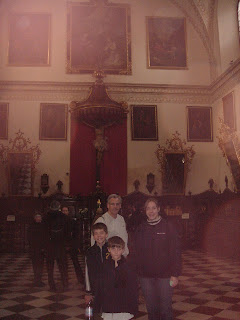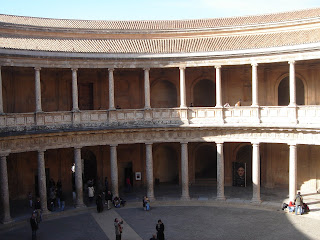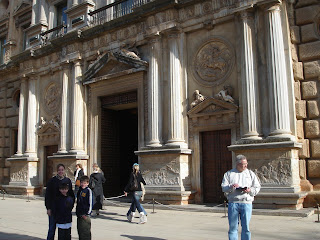Christmas in Spain - Granada
 The day before we flew back to Germany we drove east along the coast, then north through the mountains and east again to Granada. The drive was beautiful and was a bit under 2 hours. Granada was the last stronghold of the Moorish kingdom in Spain and it retains much of the flavor of the old Moorish civilization including the spectacular Alhambra fortress. We arrived around 10 AM, found a convenient parking garage and set out to see the sights of Granada.
The day before we flew back to Germany we drove east along the coast, then north through the mountains and east again to Granada. The drive was beautiful and was a bit under 2 hours. Granada was the last stronghold of the Moorish kingdom in Spain and it retains much of the flavor of the old Moorish civilization including the spectacular Alhambra fortress. We arrived around 10 AM, found a convenient parking garage and set out to see the sights of Granada.
 beautiful and the whiteness really emphasized all the wonderful pieces of art in this amazing cathedral!
beautiful and the whiteness really emphasized all the wonderful pieces of art in this amazing cathedral!

 Next we went to the Capilla Real (Royal Chapel). Queen Isabel and King Ferdinand are entombed here. They were first buried in a church on the grounds of the Alhambra but their coffins are now here under a beautiful stone monument. Guests can take stairs below to see their coffins.
Next we went to the Capilla Real (Royal Chapel). Queen Isabel and King Ferdinand are entombed here. They were first buried in a church on the grounds of the Alhambra but their coffins are now here under a beautiful stone monument. Guests can take stairs below to see their coffins. Isabel and Ferdinand's legacy can be seen and felt all over Spain. (And, of course, they financed Christopher Columbus' trip which led to his "discovery" of the New World). Their marriage united Aragon and Castile and resulted in a fast, aggressive push of Christianity/Roman Catholicism through Spain from North to South. They spent 25% of their wealth on this chapel! They made Granada the capital of Spain for a number of reasons, one of them that this was the last stronghold of the Moors and when it was conquered and she and Ferdinand united Aragon and Castile Spain was united. Photos were not allowed here but I sneaked a couple of non-flash photos. From all we saw and read it seems they really were devote Catholics but to push their faith on others using force was obviously a bad situation!
Isabel and Ferdinand's legacy can be seen and felt all over Spain. (And, of course, they financed Christopher Columbus' trip which led to his "discovery" of the New World). Their marriage united Aragon and Castile and resulted in a fast, aggressive push of Christianity/Roman Catholicism through Spain from North to South. They spent 25% of their wealth on this chapel! They made Granada the capital of Spain for a number of reasons, one of them that this was the last stronghold of the Moors and when it was conquered and she and Ferdinand united Aragon and Castile Spain was united. Photos were not allowed here but I sneaked a couple of non-flash photos. From all we saw and read it seems they really were devote Catholics but to push their faith on others using force was obviously a bad situation! And this is Ferdinand's crown. (Sorry about the blurr - I really wasn't supposed to be taking these pictures.)
And this is Ferdinand's crown. (Sorry about the blurr - I really wasn't supposed to be taking these pictures.)


The Church of Santa Ana in Plaza Nueva.
We next walked along the Alcaiceria - the old Moorish silk market. It has seven gates and many many shops lining the narrow streets. Many of the shops sell silk and jewelry which were important back in the days when Granada was ruled by the Moors.


 Now we were ready to head to the jewel of Granada - the Alhambra. The Alhambra fortress was the last stronghold of the Moorish kingdom in Spain. It is under consideration (along with 20 other sites) to become one of the new "seven wonders of the world" and we found out why! You have to plan ahead to see the Alhambra - only 350 visitors are allowed into the Palacios Nazaries (the best part) every half hour. We bought tickets online several days in advance and had only a one-half hour window in which to enter the Placios Nazaries! So, keeping an eye on our watches we hiked about 30 minutes up Cuesta de Gomerez street to the Alhambra.
Now we were ready to head to the jewel of Granada - the Alhambra. The Alhambra fortress was the last stronghold of the Moorish kingdom in Spain. It is under consideration (along with 20 other sites) to become one of the new "seven wonders of the world" and we found out why! You have to plan ahead to see the Alhambra - only 350 visitors are allowed into the Palacios Nazaries (the best part) every half hour. We bought tickets online several days in advance and had only a one-half hour window in which to enter the Placios Nazaries! So, keeping an eye on our watches we hiked about 30 minutes up Cuesta de Gomerez street to the Alhambra. The walk up was beautiful!
The walk up was beautiful!

 We were a bit early for our ticket time to enter the Palasios Nazaries we so started with the other Alhambra sites. First, Charles V's Palace.
We were a bit early for our ticket time to enter the Palasios Nazaries we so started with the other Alhambra sites. First, Charles V's Palace.

From here we headed to the Alcazaba Fort. This is the original "red castle" or "Alhambra".

 This fort complex housed and protected a town of about 2000 Muslems! The tower is in fairly good shape but the areas where the people lived are just ruins. The views of Granada from the tower are spectacular!
This fort complex housed and protected a town of about 2000 Muslems! The tower is in fairly good shape but the areas where the people lived are just ruins. The views of Granada from the tower are spectacular!

After signing the terms of surrender, the conquered Moorish king, Boabdil fled across the Sierra Nevada mountains to Africa. As he fled across the mountains he looked back at the Alhambra and saw the Christian cross and the flags of Isabel and Ferdinand (Aragon and Castile) raised on this tower and he cried. His very sensitive mother was said to have comforted him with these words - "don't weep like a woman for what you couldn't defend like a man" - now that's sensitivity!
If you look closely you can see caves dug all over this mountainside. These caves have been inhabited for cenuries - gypsies (the Roma), hippies, etc.!






This is the Court of Myrtles (Patio de los Arrayanes). It was thought that these patios were one way women, who rarely went out, could enjoy the outdoors in these patios.
This is the Grand Hall of the Ambassadors (Gran Salon de los Embajadores). It was here that the sultan sat on a throne and received foreign emissaries. The room is a perfect cube. The ceiling is made of 8000 pieces of inlaid cedar! It was amazing! Two very important historical events  took place in this room. Here in 1492 the last Moorish king (Boabdil) signed the terms of surrender and then fled to Africa. And it was in this room that Christopher Columbus presented his proposal that Isabel and Ferdinand finance his sea voyage, sailing west to reach the Orient in the east.
took place in this room. Here in 1492 the last Moorish king (Boabdil) signed the terms of surrender and then fled to Africa. And it was in this room that Christopher Columbus presented his proposal that Isabel and Ferdinand finance his sea voyage, sailing west to reach the Orient in the east.
If you have seen any pictures of the Alhambra, you have probably seen this one. this is the Courtyard of the Lions (Patio de los Leones). The stone lions are really a fountain clock - a gift from a Jewish leader of Granada. It is thought that the 12 lions represent the 12 tribes of Isreal. It used to spout water (it's a fountain) but it was also a clock - a different lion spouted water each hour. Interestingly when the Christians conquered the Moors they took the fountain apart to see how it worked and it hasn't worked since! The courtyard has 124 columns. The sections of the columns are held together by lead fittings that allow for bending (for example during earthquakes - and as you can see it has held up well, even through earthquakes!).
The stone lions are really a fountain clock - a gift from a Jewish leader of Granada. It is thought that the 12 lions represent the 12 tribes of Isreal. It used to spout water (it's a fountain) but it was also a clock - a different lion spouted water each hour. Interestingly when the Christians conquered the Moors they took the fountain apart to see how it worked and it hasn't worked since! The courtyard has 124 columns. The sections of the columns are held together by lead fittings that allow for bending (for example during earthquakes - and as you can see it has held up well, even through earthquakes!).

This is the Hall of the Abencerrajes (Sala de los Abencerrajes) - named for the legend of the Abencerraje family - in which 36 Abencerraje family members' heads were stacked in the pool in the center of this room in an attempt by the sultan to ensure that the son of his new wife (as opposed to Boabdil, the son of his first wife) would become the next sultan. Yuck!
 (As you can see, Joseph and Daniel just eat these
(As you can see, Joseph and Daniel just eat these  stories up!)
stories up!)
This is the part of the palace that Washington Irving lived in when he served as the US ambassador to Spain in 1829. He was really taken by the Alhambra and in these rooms he wrote "Tales of the Alhambra" which rekindled interest in this wonderful place and led to its recognition and preservation as a national tre asure.
asure.

 We exited the Alhambra through the Generalife Gardens. These gardens were both practical and beautiful - producing food, irriga
We exited the Alhambra through the Generalife Gardens. These gardens were both practical and beautiful - producing food, irriga ted by long aquaducts a
ted by long aquaducts a nd exquisitely manicured.
nd exquisitely manicured.




 The Patio de
The Patio de  la Acequia.
la Acequia. .
. We loved Granada! We loved Spain (and Gibraltar and Morocco)! It was a great week! Now back to Germany!
We loved Granada! We loved Spain (and Gibraltar and Morocco)! It was a great week! Now back to Germany!















































0 Comments:
Post a Comment
<< Home